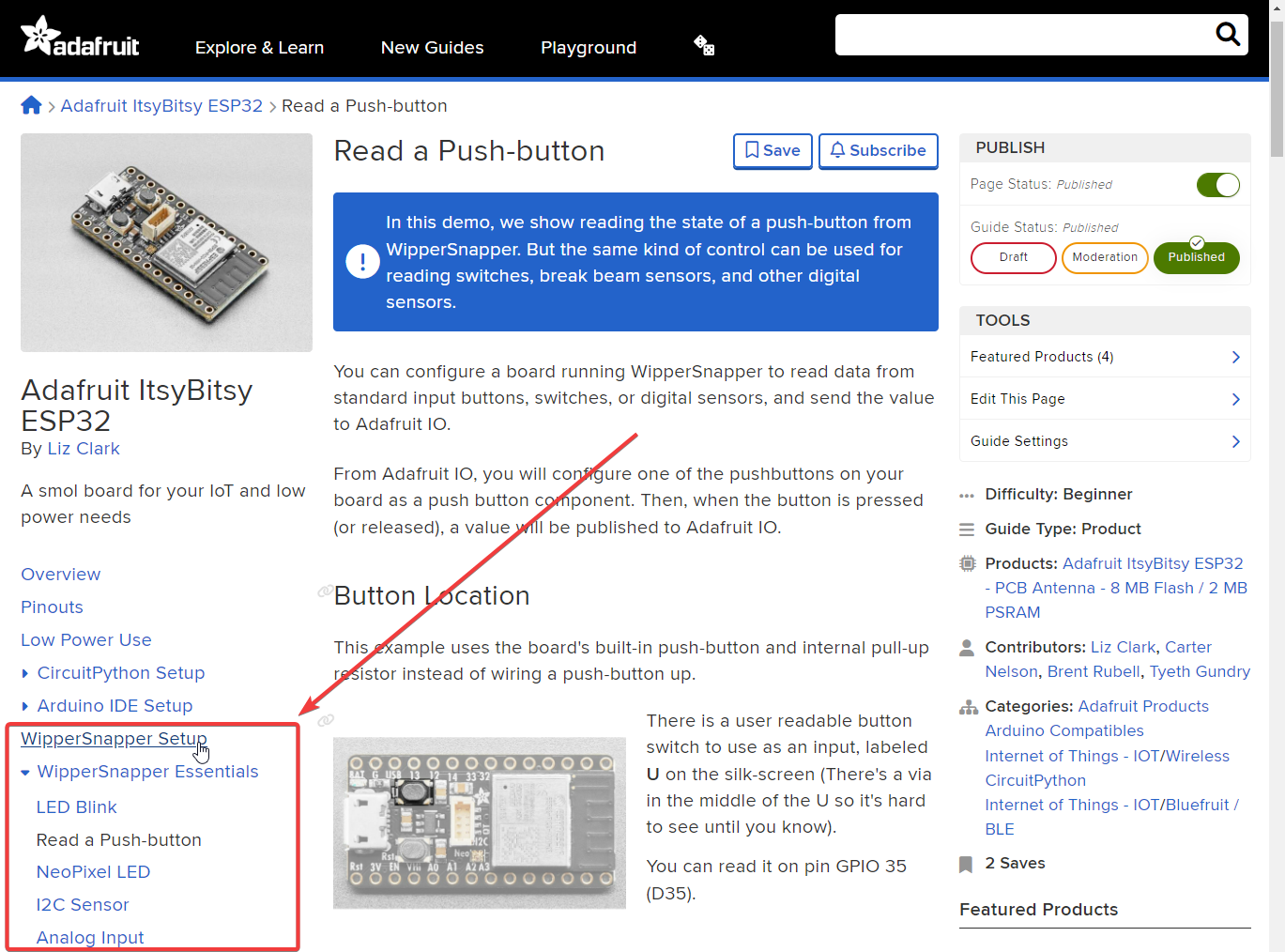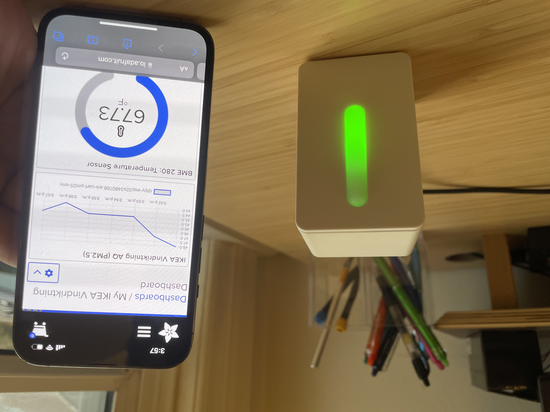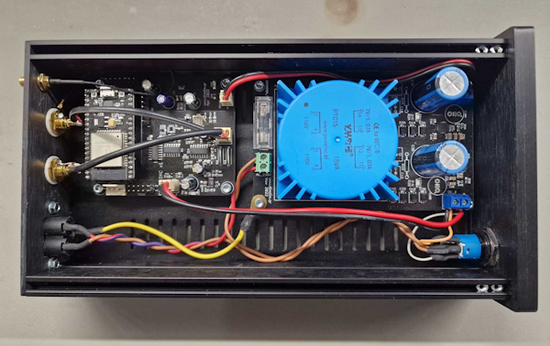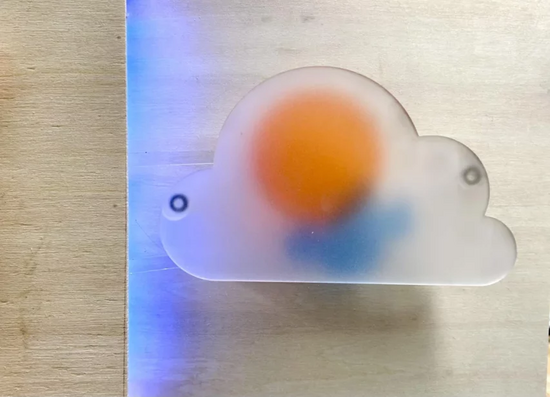-
Welcome the ItsyBitsy ESP32 to WipperSnapper

🕷️ New Board added to WipperSnapper…
What’s the second smallest board available for use with WipperSnapper, sporting all the features and pins you could ask for yet still oh so tiny? Why it’s the ItsyBitsy ESP32 of course!
Newly added this week, with accompanying docs pages in the board Learn Guide showing off the WipperSnapper Essentials to get you started in a breeze… What’s more there’s also the usual Magic Config option (Auto Config -> Magic Config), so you can instantly add the built-in button, LED and NeoPixel components to your online WipperSnapper device.

ItsyBitsy ESP32 Learn Guide showing the WipperSnapper Essentials links in sidebar menu
ItsyBitsy ESP32
Incase you haven’t heard, this new and mighty yet compact board comes with an ESP32 Pico packing 8MB flash and 2MB PSRAM, along with all the pins you could ask for (assuming you want 28 or know how to share).
It has an onboard LED + NeoPixel, reset + user buttons, PCB or external aerial options, battery input pads underneath with diode protection for external battery packs up to 6V input, and a 5V level-shifted output on D5 which is perfect for driving NeoPixels or other devices that want a 5V logic signal.

ItsyBitsy ESP32 board shown topside up
As always, if you have any suggestions or bugs to report, please let us know in the forums.
-
WipperSnapper documentation updated

A quick hello from the Adafruit IO Team to announce an important milestone, and to say “We’re Listening!”
The team have been hard at work, setting some good foundations for the year… however we’re still accepting more suggestions, feature requests, and wish-list items that you’d like to see on Adafruit IO in 2024. See the blog post or forum thread for more info, submit your ideas before the end of March via email, forum, social media, or other reliable transport methods (carrier pidgeon)… When you post, please add #AdafruitIO2024 and email iotnews@adafruit.com to let us know about your post, so we can post it on the Adafruit Blog!
What’s been going on?
📚 We’ve finally updated all the WipperSnapper boards + component’s Documentation
Documentation for the Win! All the I2C components now have their respective WipperSnapper guide page added to the product Learn Guides, and handily linked from the Component Picker dialog. We’ve also added guide pages for the other components where possible, although a few link to more general guides (like the NeoPixel Uber Guide).

Documentation links beneath each component image in the component picker, taking users to the specific component’s learn guide
Speaking of learn guides, our boards (the WipperSnapper devices) also have learn guides that contain simple instructions on using with WipperSnapper (and CircuitPython/Arduino). Detailing how to use of all the individual component types, so check those out if you’ve never looked before, and please let us know if you find any documenation related to WipperSnapper that’s out of date or incorrect.

Learn Guide for one of the supported boards on WipperSnapper, showing different component guide pages
⏲️ We’re upgrading Actions on Adafruit IO and need your feedback!
In case you missed it, or have heard the word “Blockly” and would like to know more… We’ve added Blockly based Actions to Adafruit IO, allowing a new more powerful way of creating Actions (used to automatically do things like switch a motor or send an email based on a schedule or feed value).
The IO Actions system has the same capabilities it always has, there’s simply a new way to author and edit your Actions using Blockly. We’ve written a new Learn guide covering the Blockly interface, how to use it, and some examples to demonstrate.

Blockly Actions in Adafruit IO
If you’re not into it, or you have issues with it, the old webform-based method of creating and editing your Actions is still available, for now. You can even swap back and forth, editing the same Action in either interface!
🌤️ Working in the Sun
At Adafruit, we’re dedicated to open source. All of our WipperSnapper-compatible components are created and maintained in the Wippersnapper_Components open-source JSON repository. We’re proud to be able to work in the open.
If there’s a component you’d like to see supported by WipperSnapper, head over and check the Request Issues page to see if it’s already in the works. If not, feel free to open an issue requesting your favorite component! And, if you’re handy with code, you could even get involved and contribute to the project. After all, the microcontroller code that drives WipperSnapper is open-source as well. Board contributions welcome too…
As always, if you have any suggestions or bugs to report about these new features, please let us know in the forums.
-
Adafruit IoT Monthly: DIY Doorbell Camera, Industrial Networks, and more!
IoT Projects
A Simple IoT Doorbell Camera

Build a simple IoT doorbell camera using Adafruit’s MEMENTO. Press a mini LED arcade button to snap a photo and display it on an Adafruit IO Dashboard. Photos from the doorbell are sent to your email, too! The electronics are housed in a 3D-printed snap-fit enclosure. - Adafruit Learning System
Industrial Network Playground

A “playground” to learn more about hardware and software components in industrial setups, without the need for accessing a real industrial network. - HackADay.io
IOT Squirrel House

In many parts of the world, if you have a backyard, you likely have a bunch of squirrel neighbors, and should probably just make the most of it. Maker David McDaid did just that (and more) when he built this charming IOT Squirrel House for his back garden: “a squirrel house in our back garden that would be equipped with an ESP32, a camera, motion sensor, solar power, and would integrate with my Home Assistant OS, all using as many off-the-shelf components as possible”. - Adafruit Blog
Fixing a broken smart cat feeder with ESP8266

Jeff Sandberg’s PetNet eventually stopped working because the company went out of business. This write-up covers disassembling the cat feeder, reverse engineering it, and using a custom web interface to replace the original app. - PDX.su
Replacing an Old Honeywell Thermostat with a Raspberry Pi

A DIY approach to upgrading an old mercury-based thermostat to a mesh networked system of thermometers that report to a central thermostat. - Hackster.io
IoT News and More!
We want your feedback about Adafruit IO (and WipperSnapper firmware) to help us plan 2024 (and beyond) 🚀

Inspired by Scott’s blog post, CircuitPython 2024, the developers and designers on our IoT Platform, Adafruit IO, are requesting feedback (from you!) to help guide our development of this platform in 2024.
If you’re a current Adafruit Free IO user, an Adafruit IO Plus (paid) user, or have previously used Adafruit IO in the last year, we want to hear from you!
Read more and submit your feedback here…
Designing My Smart Home From Scratch, Part Zero

Evan Grove details the process of designing a smart home from scratch after they read a “fair share of terrible, horrible, no-good, very bad news about consumer IoT products bricking themselves and/or pwning their human caretakers. I use the term “caretakers” because you don’t actually own most of these products.” The system they’re designing considers the ethical implications of which gadgets you bring into your home and starts designing a platform. - hardfault.life
Hacking a Smart Home Device

An intense case study on reverse engineering an IoT smart device and the associated network protocol it uses. -jmswrnr
-
Blockly Interface for IO Actions

Hello from the Adafruit IO Team!
Spring is just getting starting (where I am, at least!), and it’s time to bring some of that spring freshness to IO Actions with a brand new interface: Blockly!
What is Blockly?
Blockly is that seemingly-ubiquitous Google open source project behind such well-known visual programming applications as:

An example from MIT Scratch
The idea is to leave open-ended text editors and code syntax behind and simplify programming by adopting “blocks” that can be worked with spatially. Compatible blocks give a satisfying “click” when combined, giving the user positive feedback and confidence that they’ve done something right.
What’s Changed for IO Actions?
The IO Actions system has the same capabilities it always has, there’s simply a new way to author and edit your Actions using Blockly. We’ve written a new Learn guide covering the Blockly interface, how to use it, and some examples to demonstrate.

Blockly Actions in Adafruit IO
If you’re not into it, or you have issues with it, the old webform-based method of creating and editing your Actions is still available, for now. You can even swap back and forth, editing the same Action in either interface!
Why Blockly?
We think this approach will help users to visualize the options and opportunities of the Actions system a bit better. Some elements are drastically easier to understand, such as the scheduling options for Scheduled Actions (these wrap a crontab string, a notoriously difficult to understand bit of configuration.)

The new scheduling options
It’s also true that the old forms are a bit fragile, or sub-optimal in certain ways, and Blockly obviates those problems entirely. But the real excitement lies ahead…
What’s Next?
We’ve long wondered how to put more power into users’ hands with Actions, but we’ve struggled with the tradeoff between power and simplicity. At Adafruit, we always want to make things easier and avoid complicating them as much as possible. With Blockly now in hand, a clear path forward is starting to appear.
Imagine having such tools at your disposal as:
- conditionals, logic operations, comparisons
- arithmetic, variables
- multiple triggers and actions in a single Action run
- more control when and how Actions run
- Power-Ups
Stay tuned for more later this year!
As always, if you have any suggestions or bugs to report about these new features, please let us know in the forums.
-
Adafruit IoT Monthly: $5 BLE Occupancy Sensor, Ikea Sensors, and more!
IoT Projects
Building an occupancy sensor with a $5 ESP32 and a serverless DB

Matt didn’t think he would “design a full end-to-end software solution to collect occupancy data across a college campus” but he ended up doing just that. This project collects BLE beacons from nearby devices, as a count for occupancy, and sends it back to a time series database for analysis. - Matthew Science Blog
No-Code IKEA Vindriktning Air Quality Sensor Hack with Adafruit IO

The IKEA Vindriktning is an inexpensive air-quality monitor that’s readily available online (from Ikea’s website) or at a retail IKEA store. This guide will show you how to connect your Vindriktning to the Internet to log air quality data over time, without any programming required. - Adafruit Learning System
An ESP32-based internet radio streamer

Dimitris has taken an unused ESP32 board and fashioned an I2S streaming internet radio. - Adafruit Blog
Make a Weather Clock with the Feather Huzzah ESP8266

Instructables user Elaine Gao made this beautiful weather clock using a Feather Huzzah ESP8266 and Adafruit IO! - Instructables
IoT News and More!
Ikea debuts three affordable smart home sensors

Each sensor costs less than $10 and can be used to detect open doors, windows, motion or water leaks. - The Verge
Breaking Free from DRM: The Story of Hacking My Air Purifier

An investigation into the Xiaomi 4 Pro’s DRM’d Air Purifier - Unethical
